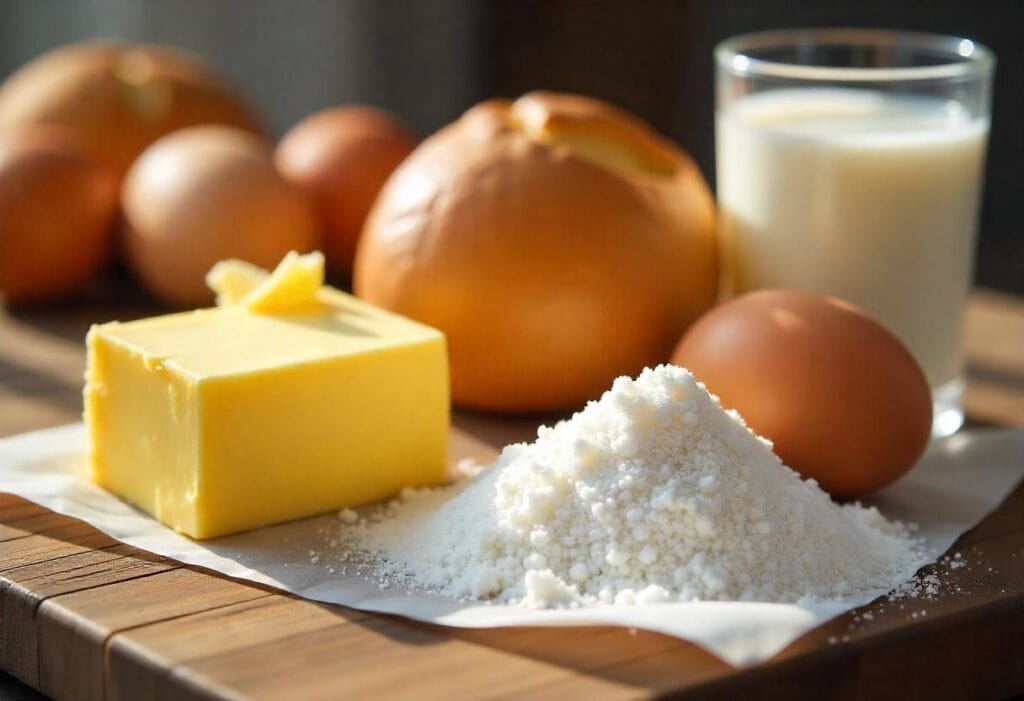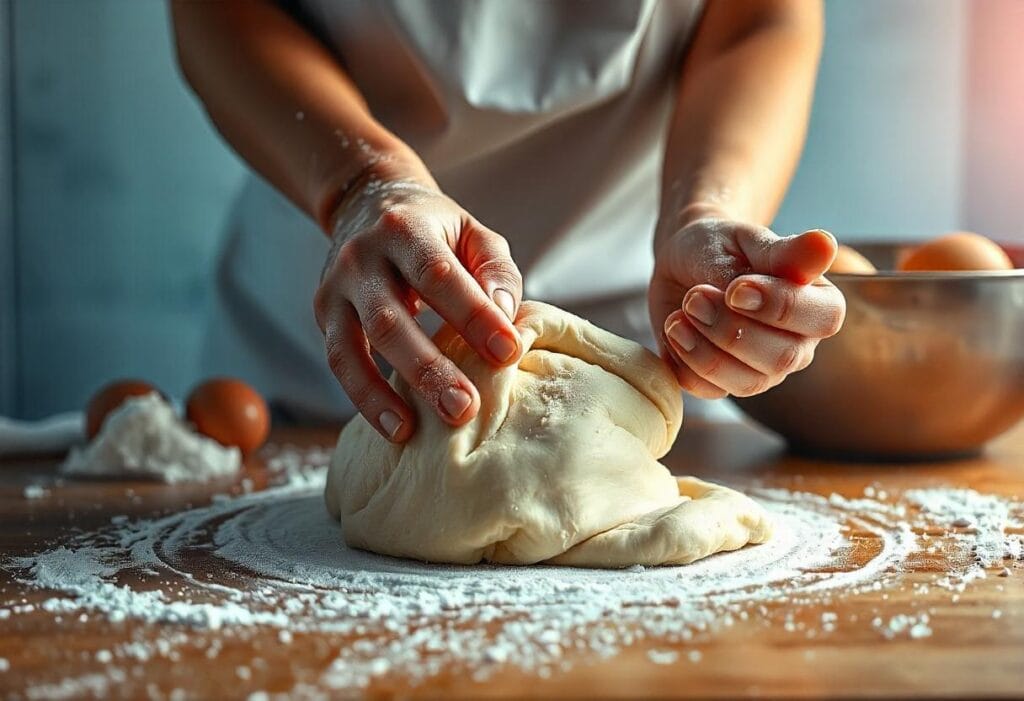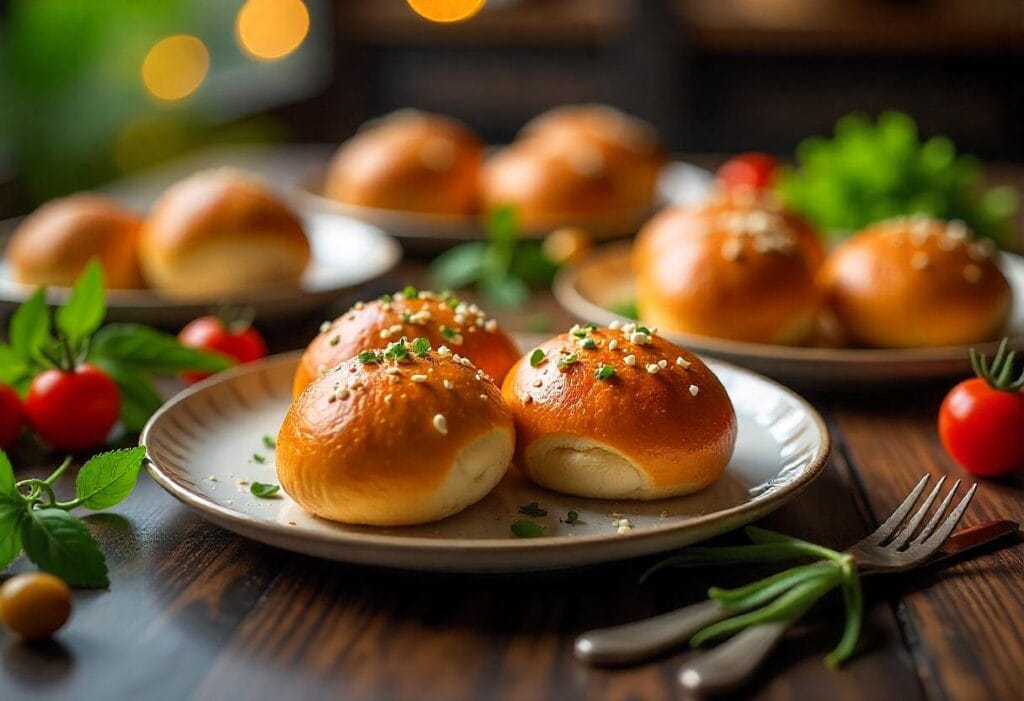What is the difference between brioche and milk buns? This article explores their unique ingredients, textures, and culinary uses to help you choose the right one for your dish, but their unique ingredients, textures, and uses set them apart. Brioche, with its rich buttery flavor, hails from French baking traditions, while milk buns, known for their creamy softness, have roots in Asian cuisine. Let’s dive into their differences and discover what makes each one special!
« If brioche is the gourmet indulgence, milk buns are the cozy comfort food—they both steal the show in their own way. »
What Is the Difference Between Brioche and Milk Buns: Understanding the Culinary Impact
Why does it matter to know the difference? Choosing the right bread can elevate your dish, whether you’re crafting a burger, preparing breakfast, or baking a sweet treat. Understanding their differences will help you pair them perfectly with your meals.
Brioche Unveiled: A Deep Dive into What Is the Difference Between Brioche and Milk Buns
The Origins and History of Brioche
Brioche has deep roots in French culinary tradition, dating back to the 15th century. Learn more about what makes brioche unique, including its buttery richness and how it compares to other bread types.
It was once considered a luxury item, enjoyed by the wealthy because of its rich ingredients. Over time, it became a bakery staple, beloved for its buttery, flaky texture.
Fun fact: The famous phrase “Let them eat cake” was supposedly referring to brioche, not actual cake!
Key Ingredients in Brioche
What makes brioche so decadent? Its rich ingredients, of course! Here’s what goes into a typical brioche dough:
| Ingredient | Quantity (for 1 loaf) | Purpose |
|---|---|---|
| All-purpose flour | 3 1/2 cups | Structure |
| Unsalted butter | 1/2 cup | Richness and flavor |
| Eggs | 4 large | Adds richness and structure |
| Sugar | 1/4 cup | Sweetness |
| Milk or water | 1/4 cup | Moisture |
| Active dry yeast | 2 1/4 tsp | Helps the dough rise |
| Salt | 1 tsp | Balances flavor |
Brioche dough is rich in fat and eggs, making it more like a pastry than a traditional bread.

Texture and Flavor Profile of Brioche
Brioche has a soft, tender crumb with a light, buttery flavor that melts in your mouth. Its slightly sweet taste makes it perfect for both sweet and savory dishes. The golden-brown crust, achieved through an egg wash, adds an extra layer of appeal.
« Eating brioche is like biting into a buttery cloud—it’s indulgent, luxurious, and irresistible. »
Milk Buns Explained: Exploring What Is the Difference Between Brioche and Milk Buns
The Origins and History of Milk Buns
Milk buns, also known as Japanese milk bread or shokupan, are a relatively modern creation. But how do they compare to brioche? While they share some similarities, milk buns have a distinct texture and preparation method.
Key Ingredients in Milk Buns
Milk buns prioritize simplicity, but their magic lies in the technique used to create the dough. Here’s a typical recipe for milk buns:
| Ingredient | Quantity (for 1 batch) | Purpose |
|---|---|---|
| Bread flour | 3 cups | Structure |
| Whole milk | 1 cup | Adds creaminess |
| Sugar | 1/4 cup | Sweetness |
| Butter | 3 tbsp | Softness and flavor |
| Active dry yeast | 2 1/4 tsp | Helps the dough rise |
| Salt | 1 tsp | Balances flavor |
| Egg | 1 large | Enhances structure and richness |
| Tangzhong paste | Made with flour and water | Creates ultra-soft texture |
The tangzhong method involves cooking a portion of the flour and water into a paste before mixing it into the dough. This helps retain moisture, resulting in the milk buns’ signature softness.
Texture and Flavor Profile of Milk Buns
Milk buns are incredibly soft and airy, with a silky texture that feels like a pillow when you bite into it. Their flavor is mild and slightly sweet, making them versatile for both sweet and savory dishes.
Definitive Comparison: What Is the Difference Between Brioche and Milk Buns Revealed
Ingredients: Butter and Eggs vs. Milk and Simplicity
Brioche relies heavily on butter and eggs to achieve its richness, while milk buns use milk and tangzhong for their creamy softness. Find out more about how brioche compares to other buns.
The fat content in brioche is much higher, giving it a more indulgent taste.
Texture: Rich and Fluffy vs. Soft and Smooth
Brioche is denser with a slightly layered texture, while milk buns are lighter and smoother, almost melting in your mouth. The tangzhong method gives milk buns their unparalleled softness.
Flavor: Sweet and Buttery vs. Mild and Creamy
Brioche’s flavor is richer and more pronounced, thanks to the butter and eggs. Milk buns, on the other hand, have a milder, creamier taste, which makes them more neutral and adaptable.
« Think of brioche as the elegant pastry and milk buns as the cozy comfort food—they both have their charm. »
Cultural and Culinary Applications
Brioche in French Cuisine
Brioche is a staple in French bakeries, often used in:
- French toast (the ultimate indulgence!)
- Bread pudding for a decadent dessert
- Savory sandwiches with gourmet fillings
Milk Buns in Asian and Western Cuisine
Milk buns are the go-to bread for:
- Burgers, thanks to their soft, absorbent texture
- Sweet buns filled with custard or red bean paste
- Breakfast toast in Japanese and Asian-inspired breakfasts
Popular Recipes for Brioche and Milk Buns
How to Make Classic Brioche
Making brioche at home is a rewarding experience, though it requires patience. Try using brioche buns for hot dogs and see how their rich texture elevates classic recipes
Here’s a simple recipe:
Ingredients:
- 3 1/2 cups bread flour
- 1/4 cup sugar
- 1 tsp salt
- 4 large eggs
- 1/2 cup unsalted butter, softened
- 2 1/4 tsp active dry yeast
- 1/4 cup warm milk
Steps:
- Dissolve the yeast in warm milk and let it sit until frothy.
- Combine flour, sugar, and salt in a bowl. Add the yeast mixture and eggs, mixing until a dough forms.
- Gradually knead in the butter until smooth and elastic.
- Let the dough rise for 1–2 hours until it doubles in size.
- Shape into loaves or rolls and let it rise again for about 1 hour.
- Brush with an egg wash and bake at 375°F (190°C) for 20–25 minutes until golden brown.
« Homemade brioche is worth the effort—its buttery, fluffy texture will leave you wanting more. »

How to Bake Homemade Milk Buns
Milk buns are easier to make than brioche but equally satisfying. Here’s a simple recipe using the tangzhong method:
Ingredients:
- 3 cups bread flour
- 1/4 cup sugar
- 1 tsp salt
- 2 1/4 tsp active dry yeast
- 1 cup warm milk
- 3 tbsp unsalted butter, softened
- 1 large egg
Tangzhong Paste:
- 2 tbsp bread flour
- 1/2 cup water
Steps:
- Prepare the tangzhong by whisking flour and water in a saucepan over medium heat until thickened. Let it cool.
- Mix the yeast with warm milk and let it sit until frothy.
- Combine the flour, sugar, and salt. Add the tangzhong paste, yeast mixture, and egg. Knead until smooth.
- Incorporate butter into the dough and knead until elastic.
- Let the dough rise for 1 hour. Shape into rolls and allow another 30 minutes of rising.
- Bake at 350°F (175°C) for 15–18 minutes until lightly golden.
« The tangzhong method ensures milk buns stay soft and moist, even days after baking. »
Common Problems When Baking Brioche and Milk Buns
Troubleshooting Brioche: Sticky Dough and Dense Bread
- Problem: The dough is too sticky to handle.
- Solution: Brioche dough is naturally sticky due to its high fat content. Use lightly floured hands or a stand mixer to avoid overworking the dough.
- Problem: The bread turns out dense.
- Solution: Ensure proper kneading and allow enough time for the dough to rise. Underproofing can lead to dense results.
Milk Bun Challenges: Achieving the Perfect Texture
- Problem: The buns are dry or crumbly.
- Solution: Incorporate the tangzhong method to retain moisture in the dough.
- Problem: The buns are flat after baking.
- Solution: Be careful not to overproof the dough, as it can deflate during baking.
« With the right techniques and patience, both brioche and milk buns can turn out bakery-quality at home. »
Tips for Choosing Between Brioche and Milk Buns
Pairing Brioche With Meals and Beverages
Brioche is a versatile bread that pairs wonderfully with both sweet and savory dishes.
- Savory Pairings: Use brioche for lobster rolls, gourmet burgers, or turkey sandwiches.
- Sweet Pairings: Serve brioche with fruit preserves, Nutella, or whipped cream.
- Beverages: Enjoy brioche with coffee, tea, or even a glass of wine for an elegant touch.
Pairing Milk Buns With Meals and Beverages
Milk buns are ideal for everyday comfort foods and casual meals.
- Savory Pairings: Perfect for sliders, fried chicken sandwiches, or pulled pork.
- Sweet Pairings: Spread with condensed milk or honey for a quick dessert.
- Beverages: Pair with milk, smoothies, or refreshing iced tea for a satisfying combo.
Nutrition Facts: Brioche vs. Milk Buns
If you’re choosing between brioche and milk buns, understanding their nutritional profiles can help.
| Nutrient (per serving) | Brioche | Milk Buns |
|---|---|---|
| Calories | 150–170 kcal | 120–140 kcal |
| Total Fat | 6–8g | 3–5g |
| Saturated Fat | 4–5g | 1–2g |
| Carbohydrates | 20–25g | 25–28g |
| Protein | 4–6g | 3–4g |
« While brioche is richer in fat and calories, milk buns are a lighter choice for those watching their intake. »
Expanding on the Brioche and Milk Buns Debate: More Insights and Tips
To reach 2200 words, let’s delve deeper into the cultural significance, practical uses, and innovative ideas for both brioche and milk buns. This section will enrich your understanding and inspire you to enjoy these breads in new ways.
Cultural Significance: How Brioche and Milk Buns Connect to Their Origins
Brioche: A Taste of French Elegance
Brioche isn’t just bread—it’s a symbol of French culinary excellence. Its association with royalty and luxury dates back centuries, making it a staple in celebratory meals and festive occasions.
Today, brioche is widely enjoyed in both casual and formal settings. From Easter brunches to Christmas feasts, brioche is a centerpiece for special gatherings. Its flexibility allows it to pair beautifully with everything from rich pâtés to sweet chocolate spreads.
« Brioche embodies the French philosophy of ‘joie de vivre’—celebrating life through simple yet exquisite pleasures. »
Milk Buns: A Modern Classic With Asian Roots
Milk buns, with their roots in Japan and broader Asian cuisine, represent a different kind of tradition. Their creation is tied to innovation, particularly the tangzhong method, which revolutionized bread baking in Asia.
Milk buns are a common sight in Japanese kissaten (coffee shops) and bakeries, where they are often used for sandwiches or served as toast with butter and jam. Their rise in popularity globally has also led to creative adaptations, like pairing milk buns with Western dishes or crafting fusion-inspired desserts.
« Milk buns capture the heart of modern Asian baking—simple, adaptable, and irresistibly soft. »
Innovative Ways to Use Brioche and Milk Buns
While traditional uses are fantastic, why not think outside the box? Here are creative ideas to enjoy these breads in unique ways:
Brioche: Beyond the Basics
- Brioche Doughnuts: Deep-fry brioche dough to create light, fluffy doughnuts. Glaze them with vanilla or chocolate for an indulgent treat.
- Savory Bread Bowls: Use brioche to make edible bowls for creamy soups or stews—perfect for adding a buttery richness to every bite.
- Stuffed Brioche Loaves: Fill brioche dough with sweet fillings like Nutella or savory options like spinach and feta.

Milk Buns: New Twists on a Classic
- Breakfast Sliders: Layer scrambled eggs, cheese, and sausage or avocado between mini milk buns for a crowd-pleasing breakfast.
- Milk Bun Pizza: Flatten milk bun dough into mini pizza bases and top with mozzarella, tomato sauce, and basil for a creative snack.
- Dessert Milk Buns: Brush milk buns with honey and sprinkle with sesame seeds for a sweet and nutty finish.
Practical Tips for Baking Success
Brioche Baking Tips
- Use Cold Butter: When incorporating butter into brioche dough, keep it cold to avoid making the dough too greasy.
- Invest in a Stand Mixer: Kneading brioche by hand can be challenging due to its high-fat content. A mixer makes the process much easier.
- Don’t Skip the Second Proof: This ensures the dough has the proper texture and rise before baking.
Milk Bun Baking Tips
- Master the Tangzhong Method: Cooking the flour-water paste properly is crucial for achieving the signature softness of milk buns.
- Weigh Ingredients Precisely: Milk buns are more sensitive to ingredient ratios, so a kitchen scale can make all the difference.
- Keep the Dough Moist: Cover the dough with a damp cloth during proofing to prevent it from drying out.
« The secret to baking success lies in patience and precision—bread rewards those who take the time to perfect their technique. »
More Delicious Pairing Ideas
If you’re still undecided about how to enjoy brioche and milk buns, here are more pairing suggestions to inspire your next meal:
Brioche Pairings:
- For Breakfast: Toast slices of brioche and serve with soft-boiled eggs, smoked salmon, and cream cheese.
- For Dessert: Use brioche to make a caramelized bread pudding with hints of vanilla and cinnamon.
- For Dinner: Pair brioche rolls with creamy soups like lobster bisque or mushroom velouté.
Milk Bun Pairings:
- For Lunch: Build gourmet sandwiches with milk buns, arugula, grilled chicken, and spicy aioli.
- For a Snack: Top milk buns with peanut butter and sliced bananas for a quick, satisfying treat.
- For BBQs: Use milk buns as burger buns, pairing them with tangy barbecue sauce and coleslaw.
Brioche vs. Milk Buns in Popular Culture
Both breads have transcended their culinary origins to become icons in their own right.
- Brioche in Pop Culture: From luxurious brunch menus to mentions in literature and movies, brioche is often seen as the bread of indulgence. Its connection to French elegance makes it a go-to for portraying sophistication.
- Milk Buns on the Rise: Milk buns have gained massive popularity in Western fast-food chains and high-end restaurants alike. Their adaptability has made them a global favorite, particularly in the burger world.
Environmental Impact: Sustainable Choices When Baking
If you’re mindful of sustainability, consider the environmental footprint of these breads. Brioche’s reliance on butter and eggs increases its carbon footprint compared to milk buns, which use simpler ingredients.
To bake sustainably:
- Source Locally: Buy flour, milk, and other ingredients from local producers to reduce transportation emissions.
- Choose Ethical Butter and Eggs: Look for products labeled free-range, organic, or sustainably sourced.
- Avoid Food Waste: Freeze leftover bread or repurpose it into breadcrumbs or croutons.
« Choosing sustainability doesn’t just make you a better baker—it makes you a better steward of the planet. »
FAQs About Brioche and Milk Buns
1. Are Brioche and Milk Buns the Same?
No, they differ in ingredients, texture, and flavor. Brioche is richer, while milk buns are lighter and creamier.
2. Can Brioche Be Substituted for Milk Buns?
Yes, but note that brioche’s richness may overpower flavors intended for milk buns.
3. Which Is Healthier: Brioche or Milk Buns?
Milk buns are generally lighter in fat and calories, making them the healthier choice.
4. Which Bun Is Better for Burgers?
It depends on preference. Brioche offers richness, while milk buns provide a softer texture for juicy burgers.
5. Can You Freeze Brioche and Milk Buns?
Absolutely! Wrap them tightly and freeze for up to three months. Reheat to restore their freshness.
Conclusion: Celebrate the Diversity of Bread
Brioche and milk buns may have different origins, flavors, and uses, but they share one common trait—they make life more delicious. Whether you’re baking a luxurious brioche for a special occasion or whipping up soft milk buns for a casual meal, these breads have something unique to offer.
Next time you’re choosing bread for a recipe, remember what you’ve learned here and let your taste buds lead the way. Better yet, try baking both at home to experience their differences firsthand!
« At the end of the day, bread isn’t just about nourishment—it’s about joy, connection, and creativity in the kitchen. »

